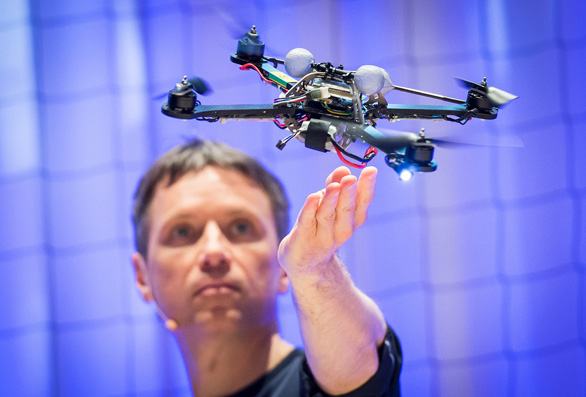
A close up look at a quadcopter, from speaker Raffaello D’Andrea’s Flying Machines demonstration lab. Photo: James Duncan Davidson
When it comes to drones, a lot of ideas float in the ether. Technologists see potential for flying machines to help us in all sorts of unexpected ways, governments take measures that seem hard and fixed, and meanwhile the media oversimplifies and dramatizes the issue. The conversation on drones is ever changing — especially with President Obama’s recent announcement that Washington would be stepping back from its use of drones, and with U.N. expert Christof Heyns calling for a collective rethinking of them. Here at TEDGlobal, the speakers in session 2, “Those Flying Things,” face the issue of what can be done — the good, the bad, the hopeful — with these flying robots.
Here are the speakers who took the stage in this second session of TEDGlobal 2013. Click on their name to read a recap of their talk:
Raffaello D’Andrea explores the possibilities of autonomous technology by collaborating with artists, architects and engineers.
Drones ecologist Lian Pin Koh expands conservation efforts by championing the use of low-cost autonomous aerial vehicles.
Andreas Raptopoulos is building a network of flying drones to carry essential goods to otherwise inaccessible areas.
Sci-fi author Daniel Suarez concocts thrilling reads from terrifying (and not-so-farfetched) near-future scenarios.
Blaise Agüera y Arcas is a Distinguished Engineer at Microsoft. His team works on augmented reality, mapping, wearable computing and natural user interfaces. He was the co-creator of Photosynth, software that assembles photos into 3D environments
Mixing pure pop with opera, jazz and classic songcraft, Elizaveta transmutes musical forms into emotional auditory experiences.
Finally, airborne ecologist Greg Asner’s mapping technology produces detailed, complex pictures of how humans’ activities affect our ecosystems.
Comments (2)
Pingback: Drones: tecnología militar, posibilidades pacíficas
Pingback: [Interview] Oubliez le transport routier de biens, les drones feront mieux